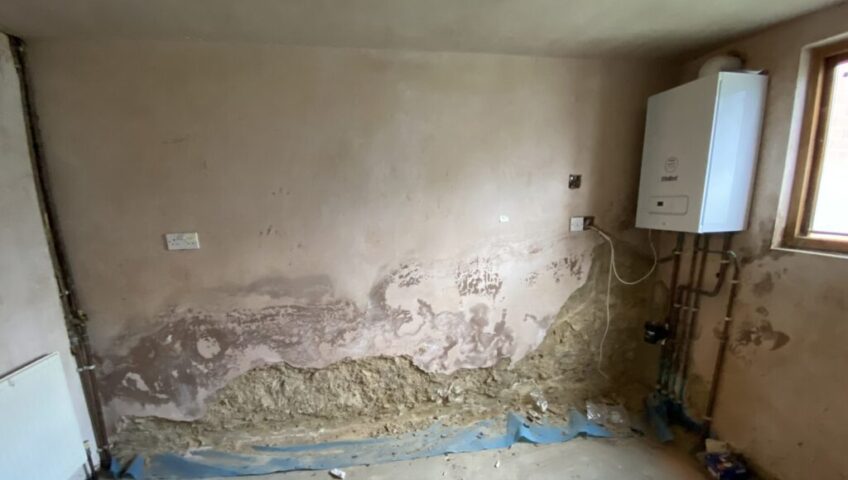
Can Rising Damp Damage the Fabric of a Building?
The English Housing Survey of 2021 found that more than 904,000 homes in England experienced issues with damp. There are many different causes of damp including penetrative damp and excess condensation, but we’re here to talk about rising damp. This type of damp happens when groundwater enters through capillaries in masonry to leave it saturated, and it can cause significant damage to the fabric of a building.
Causes of Rising Damp
The UK embraces between 800mm and 1400mm of rainfall every year, which means there’s plenty of groundwater that can get into homes. To prevent damage from rising damp, regulations for DPC were introduced in 1875, but many buildings didn’t adhere to them. This means older homes are likely to have a damaged DPC, which removes the protective barrier. In new buildings, rising damp is often caused by adjoining properties that allow water to get above the DPC.
A substance found in water called saltpetre damages the fabric of a building, but it needs time to get to work. If rising damp is left unchecked, it will lead to mould and mildew, peeling paint, and blistering walls. And this, spores released by mould can lead to serious health implications.
External Indications of Rising Damp
There are many different causes of dampness in walls, so it’s important to correctly diagnose the issue to avoid wasting money and time on incorrect treatments.
You will find evidence of rising damp on the outside of the property and inside. Common signs include material corrosion, wall discolouration, and efflorescence, which is a salt-like substance that shows up on damp bricks.
External walls aren’t the only place you will see evidence of rising damp, as water can rise through surrounding concrete. As with the walls, you will be able to see damp patches that likely won’t go away with time. If the surrounding concrete is damp, remedial action is necessary, which is where we come in.
Internal Indications of Rising Damp
On the inside of a building, rising damp will look like a wave-shaped patch of dampness that may cause damage to wallpaper and paint. In most cases, the damp mark will stretch for around 1 metre off the floor, which is where evaporation and gravity begin to prevent rising damp. Obvious indications of rising damp include:
- White, black, and green mould.
- Visible damp waves.
- Decaying timber and skirting boards.
- Efflorescence on walls.
How to Prove the Existence of Rising Damp
For some reason, many people believe that rising damp is a myth concocted by the damp-proofing industry in the UK. This simply isn’t true and it can be proven with a series of tests. For example, if you take a brick and place it into a shallow pool, you’ll notice that water rises.
Rising damp is not caused by the ground itself but by the water held in it following rainfall. Although it’s the least common type of damp, its existence and the damage it causes are very real.
Countries all over the world have regulations surrounding damp-proof courses, which further goes to show that rising damp isn’t a made-up phenomenon. If you observe historical texts, you’ll learn that Vitruvius was the first to mention rising damp in 30 BCE. He goes into detail about a type of damp-proof course, which was a layer of burnt rock and mortar laid 3 ft above the ground.
The reason why rising damp is the least common is because it is only caused by groundwater, which is why we conduct a thorough investigation to avoid misdiagnoses. To help with this, a device called an electric water metre is used, which helps build a moisture profile.
How to Treat Rising Damp
Old homes can’t simply be knocked down and rebuilt with a new DPC, which is why an intuitive remedial treatment plan is followed. The most popular strategy is to use a Damp-Proofing Cream, which is injected into the brick and replenishes the rising damp defences of a home.
How to Prevent Rising Damp
New builds in the UK are constructed with physical DPCs that prevent rising damp, but this is only effective when the new build is completely separate from any older structures. When constructing an extension or adding to an old estate, it’s essential to make sure all older properties are treated with a remedial DPC.
Treating Internal Walls
When a property suffers from rising damp and the underlying issue is addressed from the external wall, it’s easy to assume the paint can be stripped and re-applied. However, this won’t remove any trapped moisture in the skirting boards. Therefore, before the internal wall can be treated, the entire skirting needs to be removed. As well as this, any plaster with signs of saltpetre will need to be chipped away.
With the brickwork exposed from the inside, damp-proofing substances can be applied to the masonry, which will ensure the issue doesn’t come back anytime soon. Regardless of the damp-proofing technique used, a hole will need to be drilled into the wall at no less than 150mm above the external ground level. To get the spacing correct, measure 120mm between each drill point.
Finishing Up the Repair
Once you’ve addressed the issue and applied a damp-proof solution or rods to the internal wall, you can start putting the wall back together. However, you need to be aware that small traces of saltpetre will spread to certain types of plaster replacements like Gypsum. When replastering, use a salt retardant plaster and opt for a skim finish, meaning you won’t see visual differences between existing plaster.
Dampness is a common issue in UK homes that looks ugly, causes structural damage, and can lead to health complications. There are many causes of dampness, which is why it’s best to call our team to conduct a thorough investigation. After all, if the wrong treatment is applied, the damp will come back and you will end up spending more money in the future.
